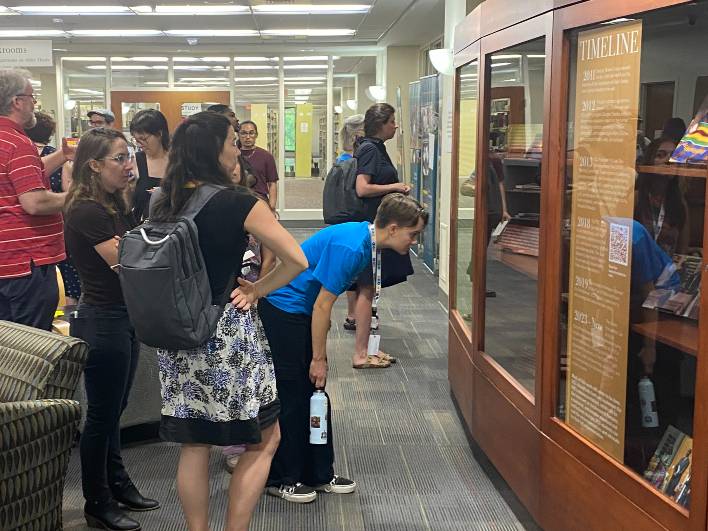Reverence & Remembrance Exhibit
July 30, 2024

In 2011, Shawn Utsey, Ph.D., released a documentary titled “Until the Well Runs Dry: Medicine and the Exploitation of Black Bodies,” which shared the history behind the Medical College of Virginia’s acts of illegal grave-robbing in the 19th century. Human remains, mostly from people of African descent, had been uncovered in 1994 in an abandoned well during the construction of the Kontos Building, part of the MCV campus. It is believed that these remains were discarded by medical staff at the college after being used in anatomy training.
When the remains were discovered, university administrators gave VCU’s Archaeological Research Center only a few days to exhume and study the skeletons that could be recovered from the well. On the final day, backhoe operators removed additional human remains, but left a portion of the well shaft unexcavated, where some of the remains are still located. Construction for the Kontos Building soon continued, covering the rest of the well. Those remains were not shown the respect they were due and were largely forgotten about until Utsey’s film.
The Office of the President subsequently convened a Family Representative Council to re-engage with these harms done and to seek proper memorialization. The FRC was selected from a series of community listening sessions to stand in for the descendant community of those uncovered in the well. Recently, the FRC has worked with Maggie Unverzagt Goddard, Ph.D., a postdoctoral fellow hired to help implement the recommendations of the Family Representative Council. Goddard, along with many others, created an exhibit that showcases all the research they have done alongside the history of the well.
A set of recommendations had been issued in 2018. Some recommendations include returning all ancestral remains to Richmond after they had been held at the Smithsonian Museum of Natural History, establishing an annual memorialization event to be observed by all medical students prior to their first anatomy class, and determining the feasibility of locating and retrieving EMSW ancestors that are still beneath the Kontos Building.
“Another goal of mine is that everyone reads the recommendations. I think it’s important for the FRC to tell the story themselves and to hear from them in their own voices,” Goddard said. “It’s really important to be a facilitator and a steward of this project [...] The work I want to do is share the recommendations as widely as possible, so that people read, interact with, know what they are and work to implement them.”
Another recommendation issued by the FRC includes the physical memorialization of the EMSW Ancestors and the construction of a significantly appropriate memorial. Cynthia Lane, a VCUarts student, has created a speculative memorial sculpture that would replace the Dooley Arch, the last Confederate memorial on the VCU campus. The sculpture, made out of candles, commemorates those who were uncovered.
“The number of people that were found doesn’t even start to scrape the surface of all the history VCU is hiding,” Lane said. “I wanted to try to represent every single one of them.”
Due to the distance between the Monroe Park campus and the MCV campus, the EMSW team is working hard to connect the two through their shared history. Sarah Clay, a Research and Collections Specialist at Special Collections and Archives at VCU Libraries emphasizes the importance of the connection between the two campuses.
“It’s really important for undergrad students to recognize that VCU wouldn’t have been here without MCV,” Clay said. “That history is really important and still part of their legacy. It’s really beneficial to harness the political activism that we have on this campus and inform them on the history [...] I’m really excited for them to be educated on the history of the institution.”
The EMSW exhibit contains six cases full of artifacts and research, such as the history of the VCU seal and the merging of MCV and RPI, the response in 1994 from VCU administration to the discovery of the well, the forming of the FRC and the issuing of the recommendations in 2018, and the return of the remains from the Smithsonian in 2019.
Currently, the remains are undergoing extensive DNA analysis to match each set, as they were commingled when they were returned to Richmond, in order to reconstitute each individual and bury them with dignity.
In addition to the exhibit, several VCU history department faculty are involved in the EMSW project. They include Michael Dickinson, PhD, who is co-director of the HRC Health Humanities Lab East Marshall Street Oral History Project. Karen Rader, Ph.D. and Ryan Smith, Ph.D., have served on the EMSW Interment and Memorialization Committee, which Rader co-chaired, and Rader has also served on the EMSW Planning Committee with John Kneebone, Ph.D. (retired). Many VCU students have also contributed to the project and its research.
The exhibit is open year-round and is available to view on the fourth floor of Cabell Library.